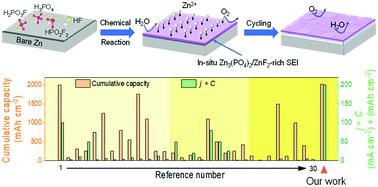当前位置:
X-MOL 学术
›
Energy Environ. Sci.
›
论文详情
Our official English website, www.x-mol.net, welcomes your feedback! (Note: you will need to create a separate account there.)
In situ built interphase with high interface energy and fast kinetics for high performance Zn metal anodes
Energy & Environmental Science ( IF 32.5 ) Pub Date : 2021-4-30 , DOI: 10.1039/d1ee00308a Yuzhu Chu 1, 2, 3, 4, 5 , Shu Zhang 5, 6, 7, 8 , Shuang Wu 5, 9, 10, 11, 12 , Zhenglin Hu 5, 9, 10, 11, 12 , Guanglei Cui 5, 6, 7, 8 , Jiayan Luo 1, 2, 3, 4, 5
Energy & Environmental Science ( IF 32.5 ) Pub Date : 2021-4-30 , DOI: 10.1039/d1ee00308a Yuzhu Chu 1, 2, 3, 4, 5 , Shu Zhang 5, 6, 7, 8 , Shuang Wu 5, 9, 10, 11, 12 , Zhenglin Hu 5, 9, 10, 11, 12 , Guanglei Cui 5, 6, 7, 8 , Jiayan Luo 1, 2, 3, 4, 5
Affiliation

|
In situ construction of a multifunctional solid electrolyte interphase (SEI) for Zn anodes is promising to address the dendrite growth and side reactions (corrosion and hydrogen evolution) in aqueous Zn-ion batteries. However, there is a lack of constructive methods for choosing suitable SEI compounds and feasible implementation routes. Here, inspired by the SEI-design for Li-metal batteries, we identified that Zn3(PO4)2 with high interface energy could suppress Zn dendrite growth effectively and ZnF2 could accelerate the kinetics of Zn2+ transference and deposition, and thus constructing a composite SEI mainly composed of Zn3(PO4)2 and ZnF2 (ZCS) is likely to improve interface deposition and electrode kinetics comprehensively. However, the high redox potential of Zn/Zn2+ and H2/H+ makes it difficult to develop an in situ SEI for Zn anodes in aqueous electrolytes via traditional electrochemical routes. Considering this dilemma, we take advantage of the instability of KPF6 in an aqueous environment and build in situ ZCS on the Zn anode through the PF6− anion-induced chemical strategy. Surprisingly, ZCS-Zn exhibits enhanced reversibility with a smooth and compact structure during long-term cycling. Both cumulative capacity (2020 mA h cm−2) and the product of the largest current density and areal capacity (10 mA cm−2 × 20 mA h cm−2) applied to ZCS-Zn reach the highest levels compared with those reported in recent reports under mildly acidic conditions. This work paves a new way for designing a desirable SEI on the Zn anode and may also guide the interface engineering of other systems to overcome the intrinsic defects in constructing favorable interphases.
中文翻译:

用于高性能Zn金属阳极的具有高界面能和快速动力学的原位构建相间
用于锌阳极的多功能固体电解质中间相(SEI)的原位构建有望解决含水Zn离子电池中的枝晶生长和副反应(腐蚀和氢析出)。然而,缺乏用于选择合适的SEI化合物和可行的实施途径的建设性方法。在这里,受锂金属电池SEI设计的启发,我们发现具有高界面能的Zn 3(PO 4)2可以有效地抑制Zn枝晶的生长,而ZnF 2可以加速Zn 2+迁移和沉积的动力学,并且从而构建了主要由Zn 3(PO 4)组成的复合SEI2和ZnF 2(ZCS)可能会全面改善界面沉积和电极动力学。然而,Zn / Zn 2+和H 2 / H +的高氧化还原电势使得难以通过传统的电化学途径为水性电解质中的Zn阳极开发原位SEI。考虑这种困境,我们利用KPF的不稳定性的6在水性环境中并积聚在原位上的锌阳极ZCS通过PF 6 -阴离子诱导的化学策略。出乎意料的是,ZCS-Zn在长期循环中表现出增强的可逆性,并具有光滑紧凑的结构。ZCS-Zn的累积容量(2020 mA h cm -2)和最大电流密度与面积容量的乘积(10 mA cm -2 ×20 mA h cm -2)均达到最高水平。在弱酸性条件下的最新报道。这项工作为在锌阳极上设计理想的SEI铺平了一条新途径,并且还可以指导其他系统的界面工程,以克服构造有利的相间的固有缺陷。
更新日期:2021-05-17
中文翻译:

用于高性能Zn金属阳极的具有高界面能和快速动力学的原位构建相间
用于锌阳极的多功能固体电解质中间相(SEI)的原位构建有望解决含水Zn离子电池中的枝晶生长和副反应(腐蚀和氢析出)。然而,缺乏用于选择合适的SEI化合物和可行的实施途径的建设性方法。在这里,受锂金属电池SEI设计的启发,我们发现具有高界面能的Zn 3(PO 4)2可以有效地抑制Zn枝晶的生长,而ZnF 2可以加速Zn 2+迁移和沉积的动力学,并且从而构建了主要由Zn 3(PO 4)组成的复合SEI2和ZnF 2(ZCS)可能会全面改善界面沉积和电极动力学。然而,Zn / Zn 2+和H 2 / H +的高氧化还原电势使得难以通过传统的电化学途径为水性电解质中的Zn阳极开发原位SEI。考虑这种困境,我们利用KPF的不稳定性的6在水性环境中并积聚在原位上的锌阳极ZCS通过PF 6 -阴离子诱导的化学策略。出乎意料的是,ZCS-Zn在长期循环中表现出增强的可逆性,并具有光滑紧凑的结构。ZCS-Zn的累积容量(2020 mA h cm -2)和最大电流密度与面积容量的乘积(10 mA cm -2 ×20 mA h cm -2)均达到最高水平。在弱酸性条件下的最新报道。这项工作为在锌阳极上设计理想的SEI铺平了一条新途径,并且还可以指导其他系统的界面工程,以克服构造有利的相间的固有缺陷。



























 京公网安备 11010802027423号
京公网安备 11010802027423号